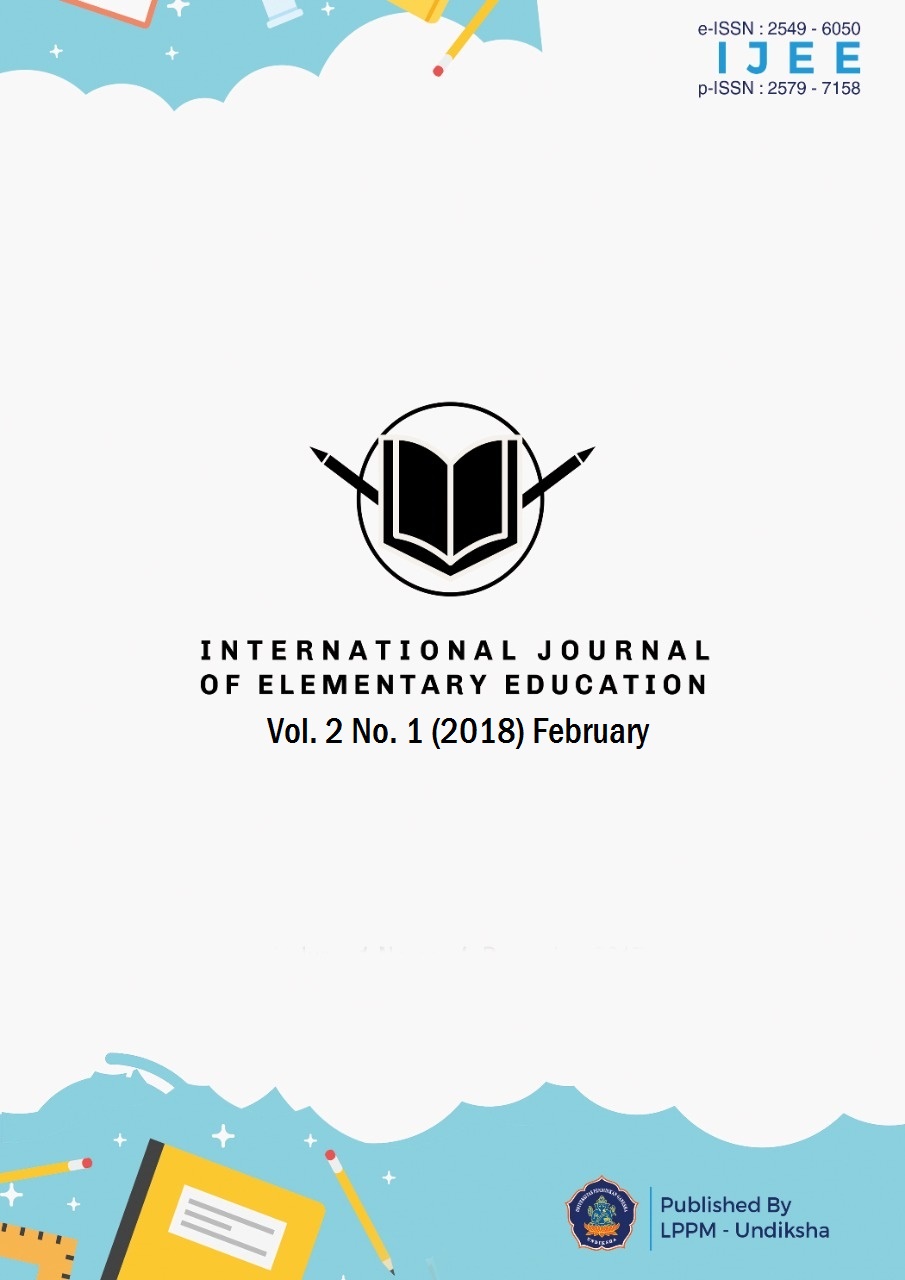Superflex: Innovative Learning to Develop Social Attitude Competencies
DOI:
https://doi.org/10.23887/ijee.v1i1.11999Abstract
The 2013 curriculum aims to produce students to have three competencies: attitude, knowledge and skills. Competence of attitude is divided into two, namely spiritual and social. Competence of social attitude is done during the learning process and assessment. But not on all subjects, the process and attitude assessment is done by the teacher. Assessment of attitudes in primary schools is done by classroom teachers, teachers of religious instruction lessons, PJOK, and extracurricular coaches. Social attitude is an integral part of social thinking because attitude is the fruit of thought. Learning Superflex® is a model developed in 2008 in the United States and in this research is adapted to help address issues related to social attitudes. This research uses descriptive analysis method. Some of the data is taken from the results of research that the author did and still runs until this year. The data is collaborated with the data obtained from the literature to produce this study. The conclusion of this study that innovative learning model depends on the creativity of teachers in generating motivation learners. The Superflex® learning model can be an inspiration for teachers as one of the innovative learning models that can build students' social attitudes.
References
Baker, K. E. (2011). Detectives and Superheroes: A Pilot Study Teaching Flexible Thinking in Social Situations to a Child with High Functioning Autism. Thesis. St. Catharines, Ontario: Faculty of Social Sciences, Brock University.
Crooke, P., & Winner, M. G. (2015, Maret). 10 DOs and DON'T for Teaching Superflex. Think Social Publishing,inc.
Cross, S. (2012, Februari 14). Describing Teaching and Learning Innovation. Retrieved Mei 7, 2012, from Teaching and Learning Design, Research and Developments : http://latestendeavour.wordpress.com/2012/02/14/describing-teaching-and-learning-innovation/
Direktorat Pembinaan Sekolah Dasar. (2015). Panduan Penilaian untuk Sekolah Dasar (SD). Jakarta: Kemdikbud Dirjen Pendidikan Dasar dan Menengah.
http://www.socialthinking.com/what-is-social-thinking/introduction. (2011, September 28). Introduction to Social Thinking. Retrieved from social thinking website: http://www.socialthinking.com/what-is-social-thinking/introduction
Husodo, S. Y. (2015, November 25). Guru, "Sing Digugu lan Ditiru". Retrieved Mei 6, 2017, from Kompas.com: http://nasional.kompas.com/read/2015/11/25/15000011/Guru.Sing.Digugu.lan.Ditiru.
Jendela Pendidikan dan Kebudayaan. (2016, Juni). Perbaikan Kurikulum 2013: Perbaikan untuk Kebaikan. Retrieved Mei 1, 2017, from BPMTV Kemdikbud: http://bpmtv.kemdikbud.go.id/majalahs/UOBPcjV1vqZ65KUQl2wtQVDCMRqAkiVf6w5iQ0kl20161105143449.pdf
Lai, T. (2008, Agustus 2). Buzz Word: 21st Century Learning Skills. Retrieved Mei 10, 2012, from Education innovation weblog: http://educationinnovation.typepad.com/my_weblog/2008/08/buzz-word-21st-century-learning-skills.html
Lampiran Permendikbud No. 24. (2016). Kompetensi Inti dan Kompetensi Dasar Pelajaran pada Kurikulum 2013 pada Pendidikan Dasar dan Menengah. Jakarta, Indonesia: Kementerian Pendidikan dan Kebudayaan.
Lestari, N. D. (2015). Identifikasi Sikap Sosial Siswa Kelas V SD. Fakultas Ilmu Pendidikan , Program Studi Pendidikan Guru Sekolah Dasar. Yogyakarta: Universitas Negeri Yogyakarta.
Linton, B. (2015, Oktober 12). Social Thinking Across the Home and School Da: The I LAUGH Model of Social Thinking. Retrieved from Social Thinking Publishing: http://www.osspeac.org/wp-content/uploads/2015/08/Day-A-and-M-ppt-handouts.pptx.pdf
Madrigal, S., & Winner, M. G. (2008). Superflex: A Superhero Social Thinking Curriculum. www.socialthinking.com.
Purwanto. (2016). Implementasi Penilaian Sikap Berdasarkan Kurikulum 2013 pada Pembelajaran Bahasa Indonesia untuk Membentuk Karakter Siswa di Sekolah Menengah Pertama. Universitas Muhammadiyah Surakarta, Sekolah Pascasarjana. Surakarta: Program Studi Magister Pengkajian Bahasa.
Rachmah, H. (2012). Inovasi Pembelajaran IPS untuk Generasi Z. Seminar Nasional "Inovasi Pembelajaran IPS" (pp. 167-175). Bandung: Program Studi Pendidikan IPS SPs UPI.
Rachmah, H. (2013). Model of Integrative Learning in Indonesia: an Alternative. Seminar Nasional Pendidikan Sejarah "Menyongsong Kurikulum Sejarah 2013". Jakarta: APPS dan Jurusan Sejarah FIS UNJ.
Rachmah, H. (2014). Pengembangan Profesi Pendidikan IPS. Bandung: Alfabeta.
Rachmah, H., Gunawan, R., & Mulyani, M. (2016). Model Pembelajaran Superflex untuk Mengekspolari Kemampuan Kognisi Sosial (Studi pada SIswa Sekolah Dasar Inklusi Kota Cimahi Jawa Barat). STKIP Pasundan. Jakarta: Kemenristek Dikti.
Riyati, Y. (2012). Pengaruh Kompetensi Sosial Guru terhadap Sikap Sosial Siswa Kelas VIII di Madrasah Tsanawiyah Yakti Tegalrejo Magelang. STAIN Salatiga, Jurusan Tarbiyah. Salatiga: Program Studi Pendidikan Islam.
Rufaida, S. D. (2013). Pengembangan Sikap Sosial Siswa Menggunakan Pendekatan Pakem pada Pembelajaran IPS Kelas VB SD Negeri Mangiran Kecamatan Srandakan Kabupaten Bantul. Fakultas Ilmu Pendidikan, Jurusan Pendidikan Pra Sekolah dan Sekolah Dasar. Yogyakarta: Program Studi PGSD.
Suharmanto, A. (2008). Perencanaan dan Pembelajaran Inovatif. Semarang: Jurusan Teknik Mesin FT Universitas Negeri Semarang.
Winner, M. G. (2014). Superflex, the Team of Unthinkables and the Five-Step Power Plan. Retrieved Maret 28, 2015, from social thinking website: http://www.socialthinking.com/what-is-social-thinking/superflex-the-unthinkables-and-the-five-step-power-plan
Winner, M. G. (2015). Superflex® the Team of Unthinkables and the Five-Step Power Plan. Retrieved Juni 14, 2016, from Social Thinking: https://www.socialthinking.com/Articles?name=Superflex%20the%20Team%20of%20Unthinkables%20and%20the%20Five-Step%20Power%20Plan
Published
How to Cite
Issue
Section
License
Authors who publish with the International Journal of Elementary Education agree to the following terms:
- Authors retain copyright and grant the journal the right of first publication with the work simultaneously licensed under a Creative Commons Attribution License (CC BY-SA 4.0) that allows others to share the work with an acknowledgment of the work's authorship and initial publication in this journal.
- Authors are able to enter into separate, additional contractual arrangements for the non-exclusive distribution of the journal's published version of the work (e.g., post it to an institutional repository or publish it in a book), with an acknowledgment of its initial publication in this journal.
- Authors are permitted and encouraged to post their work online (e.g., in institutional repositories or on their website) prior to and during the submission process, as it can lead to productive exchanges, as well as earlier and greater citation of published work. (See The Effect of Open Access)









